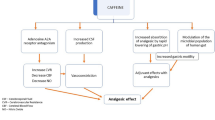Abstract
Introduction
Over-the-counter herbal and alternative medicines are classified as dietary supplements and, unlike drugs, are not rigorously regulated by the United States Food and Drug Administration. Their potential adverse effects are often poorly characterized.
Method
Red clover, dong quai, and Siberian ginseng are herbal compounds used for treatment of perimenopausal symptoms such as hot flashes. These compounds are known to contain coumarins, and thus carry the potential for hemorrhagic complications; however, no cases of intracranial hemorrhage have been reported.
Discussion
We report a 53-year-old woman with spontaneous subarachnoid hemorrhage due to the use of an herbal supplement containing red clover, dong quai, and Siberian ginseng.




Similar content being viewed by others
References
Ryu SJ, Chien YY. Ginseng-associated cerebral arteritis. Neurology 1995;45(4):829–30.
National center for complementary and alternative medicine. Herbs at a Glance. nccam.nih.gov. Accessed July 31, 2006.
Natural medicines comprehensive database. www.NaturalDatabase.com. Accessed August 1, 2006.
Abebe W. Herbal medication: potential for adverse interactions with analgesic drugs. J Clin Pharm Therapeut 2002;27:391–401.
Heck AM, DeWitt BA, Lukes AL. Potential interactions between alternative therapies and warfarin. Am J Health-Syst Pharm 2000;57:1221–30.
Page RL, Lawrence JD. Potentiation of warfarin by dong quai. Pharmacotherapy 1999;19(7):870–6.
Prescribing Information Coumadin. Bristol-Myers Squibb Company, Princeton, NJ; 2005, 08543.
Ernst E. The risk–benefit profile of commonly used herbal therapies: Ginkgo, St. John’s Wort, Ginseng, Echinacea, Saw Palmetto, and Kava. Ann Intern Med 2002;136:42–53.
Hodges PJ, Kam PCA. The peri-operative implications of herbal medicines. Anaesthesia 2002;57:889–99.
Fugh-Berman A. Herbal medicinals. Selected clinical considerations, focusing on known or potential drug–herb interactions. Arch Int Med 1999;159:1857–8.
Janetzky K, Morreale AP. Probable interaction between warfarin and ginseng. Am J Health Syst Pharm. 1997;54:692–3.
Ulbricht C, Basch E, Sollars D, et al. Wild yam. J Herb Pharmacother 2003;3(4):77–91.
Department of Health and Human Services Healthfinder. http://www.healthlibrary.epnet.com. Accessed July 31, 2006.
Koch E. Extracts from fruits of saw palmetto (Sabal serrulata) and roots of stinging nettle (Urtica dioica): viable alternatives in the medical treatment of benign prostatic hyperplasia and associated lower urinary tracts symptoms. Planta Med 2001;67(6):489–500.
Author information
Authors and Affiliations
Corresponding author
Rights and permissions
About this article
Cite this article
Friedman, J.A., Taylor, S.A., McDermott, W. et al. Multifocal and Recurrent Subarachnoid Hemorrhage Due to an Herbal Supplement Containing Natural Coumarins. Neurocrit Care 7, 76–80 (2007). https://doi.org/10.1007/s12028-007-0075-z
Published:
Issue Date:
DOI: https://doi.org/10.1007/s12028-007-0075-z




